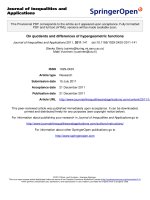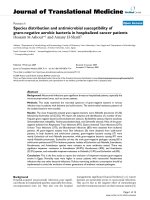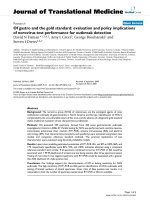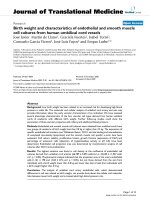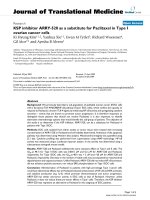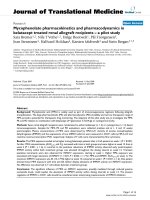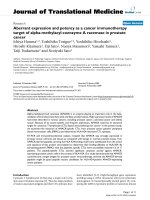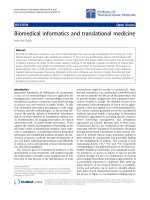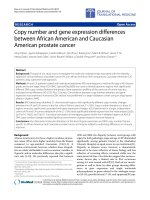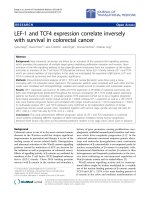Báo cáo hóa học: " Solvent exposure and malignant lymphoma: a population-based case-control study in Germany" pptx
Bạn đang xem bản rút gọn của tài liệu. Xem và tải ngay bản đầy đủ của tài liệu tại đây (282.74 KB, 11 trang )
BioMed Central
Page 1 of 11
(page number not for citation purposes)
Journal of Occupational Medicine
and Toxicology
Open Access
Research
Solvent exposure and malignant lymphoma: a population-based
case-control study in Germany
Andreas Seidler*
1
, Matthias Möhner
1
, Jürgen Berger
2
, Birte Mester
3,4
,
Evelin Deeg
5
, Gine Elsner
3
, Alexandra Nieters
5
and Nikolaus Becker
5
Address:
1
Federal Institute of Occupational Safety and Health (BAuA), Berlin, Germany,
2
Department of Medical Informatics, University Medical
Center Hamburg-Eppendorf, Germany,
3
Institute of Occupational Medicine, Johann Wolfgang Goethe-University, Frankfurt/Main, Germany,
4
Bremen Institute for Prevention Research and Social Medicine, Bremen, Germany and
5
German Cancer Research Center (DKFZ), Division of
Cancer Epidemiology, Heidelberg, Germany
Email: Andreas Seidler* - ; Matthias Möhner - ;
Jürgen Berger - ; Birte Mester - ; Evelin Deeg - ;
Gine Elsner - ; Alexandra Nieters - ; Nikolaus Becker -
* Corresponding author
Abstract
Aims: To analyze the relationship between exposure to chlorinated and aromatic organic solvents and malignant
lymphoma in a multi-centre, population-based case-control study.
Methods: Male and female patients with malignant lymphoma (n = 710) between 18 and 80 years of age were
prospectively recruited in six study regions in Germany (Ludwigshafen/Upper Palatinate, Heidelberg/Rhine-
Neckar-County, Würzburg/Lower Frankonia, Hamburg, Bielefeld/Gütersloh, and Munich). For each newly
recruited lymphoma case, a gender, region and age-matched (± 1 year of birth) population control was drawn
from the population registers. In a structured personal interview, we elicited a complete occupational history,
including every occupational period that lasted at least one year. On the basis of job task-specific supplementary
questionnaires, a trained occupational physician assessed the exposure to chlorinated hydrocarbons
(trichloroethylene, tetrachloroethylene, dichloromethane, carbon tetrachloride) and aromatic hydrocarbons
(benzene, toluene, xylene, styrene). Odds ratios (OR) and 95% confidence intervals (CI) were calculated using
conditional logistic regression analysis, adjusted for smoking (in pack years) and alcohol consumption. To increase
the statistical power, patients with specific lymphoma subentities were additionally compared with the entire
control group using unconditional logistic regression analysis.
Results: We observed a statistically significant association between high exposure to chlorinated hydrocarbons
and malignant lymphoma (Odds ratio = 2.1; 95% confidence interval 1.1–4.3). In the analysis of lymphoma
subentities, a pronounced risk elevation was found for follicular lymphoma and marginal zone lymphoma. When
specific substances were considered, the association between trichloroethylene and malignant lymphoma was of
borderline statistical significance. Aromatic hydrocarbons were not significantly associated with the lymphoma
diagnosis.
Conclusion: In accordance with the literature, this data point to a potential etiologic role of chlorinated
hydrocarbons (particularly trichloroethylene) and malignant lymphoma. Chlorinated hydrocarbons might affect
specific lymphoma subentities differentially. Our study does not support a strong association between aromatic
hydrocarbons (benzene, toluene, xylene, or styrene) and the diagnosis of a malignant lymphoma.
Published: 2 April 2007
Journal of Occupational Medicine and Toxicology 2007, 2:2 doi:10.1186/1745-6673-2-2
Received: 14 February 2007
Accepted: 2 April 2007
This article is available from: />© 2007 Seidler et al; licensee BioMed Central Ltd.
This is an Open Access article distributed under the terms of the Creative Commons Attribution License ( />),
which permits unrestricted use, distribution, and reproduction in any medium, provided the original work is properly cited.
Journal of Occupational Medicine and Toxicology 2007, 2:2 />Page 2 of 11
(page number not for citation purposes)
Background
During the past decades the incidence of Non-Hodgkin
lymphoma (NHL) increased in most western countries [1-
4]. Only recent data indicate a potential leveling off of this
trend. In Germany, NHL made up an estimated 2.7 of the
male and 3.0% of the female incident cancer-cases in
2002 [5].
Several studies point to a potential etiologic role of sol-
vents to malignant lymphoma. In the analysis of occupa-
tional groups with potential solvent exposure, Hodgkin
lymphomas (HL) have been found in excess among paint-
ers [6] and workers in the chemical industry exposed to
solvents [7]. Elevated Non-Hodgkin lymphoma (NHL)
risks have been found among painters [8]; metal workers
[9]; shoe makers and cobblers [10]; printers [11] and
leather manufacturers [12]. In a previous occupation-
related analysis of this study [13] based on the new WHO-
classification [14,15], the following occupational groups
with potential solvent exposure are positively associated
with malignant lymphoma: printers; rubber and plastic
product makers; shoemakers; bricklayers; carpenters; and
other construction workers; maids on the level of house-
hold application; plumbers, welders, sheet metal and
structural metal preparers, and erectors; metal processors;
machinery fitters; and cabinet makers. However, in our
study several occupations which can be expected to be
prone to solvent exposure (e.g., dry-cleaners, painters) are
not associated with lymphoma diagnosis.
The aim of the present multi-centre, population-based
case-control study is therefore to examine the association
between exposure to chlorinated hydrocarbons and lym-
phoma based on an in-depth expert assessment of solvent
exposure.
Methods
Study population
The study design has been described in detail in previous
publications [16,17]. Briefly, the study was conducted
under the leadership of the German Cancer Research
Center (DKFZ) in six defined regions in Germany: Lud-
wigshafen/Upper Palatinate, Heidelberg/Rhine-Neckar-
County, Würzburg/Lower Frankonia, Hamburg,
Bielefeld/Guetersloh, and Munich. In the mentioned
study areas, all hospital and ambulatory physicians
involved in the diagnosis and therapy of malignant lym-
phoma were asked to identify prospectively all patients
between 18 and 80 years with newly diagnosed lym-
phoma (NHL and HL). Lymphoma patients were required
to be resident in the study area and to be familiar with the
German language. Of 710 participating lymphoma
patients (participation rate = 87.4%), 115 suffered from
HL, 554 suffered from B-NHL, 35 from T-NHL, 1 suffered
from combined B-NHL and HL, and 5 from other lym-
phoma.
For each newly recruited lymphoma case, a gender, region
and age-matched (± 1 year of birth) population control
was drawn from the population registration office. Con-
trol subjects that were not familiar with the German lan-
guage were excluded from the study. For each participant
who had to be excluded from the study or rejected partic-
ipation, the recruitment procedure was repeated. Among
population controls the participation rate was 44.3%. A
total of 710 case-control pairs were included in the analy-
sis.
Data collection
Intensively trained interviewers elicited detailed informa-
tion about the medical history (including medication),
lifestyle (including smoking, alcohol consumption, and
leisure time activities), and occupation. The interviewers
documented a complete occupational history, including
every occupational period that lasted at least one year. For
every job held, information was elicited about the start
and the end of the job phase, about job title, industry, and
specific job tasks. Study subjects having held jobs with
potential relevance for lymphomagenesis (e.g., painters
and lacquerers; metal workers and welders; chemical
workers; shoemakers and leather workers; textile workers;
dry cleaners; painters) were additionally asked to reply to
job task-specific supplementary questions. For this pur-
pose, a set of 14 job task-specific supplementary question-
naires had been developed following Bolm-Audorff et al.
[18].
Exposure assessment
A trained industrial physician (B.M.) assessed – blind to
the case-control status – the intensity and frequency of
exposure to specific chlorinated hydrocarbons (trichlo-
roethylene, tetrachloroethylene, carbon tetrachlorine
CTET, dichloromethane DCM) and to aromatic hydrocar-
bons (benzene, toluene, xylene, styrene). In a European
collaborative research project with acronym EPILYMPH,
this expert assessment has been coordinated by the Inter-
national Agency for Research on Cancer (IARC) in Lyon.
Quality assurance of expert exposure assessment included
regular expert meetings and inter-rater-crosschecks of con-
crete assessment examples.
The intensity of exposure to specific solvents was assessed
on a semiquantitative three point scale (low, medium,
and high exposure), representing the absolute level of
exposure in ppm. Intensity of exposure to trichloroethyl-
ene, perchloroethylene, carbon tetrachlorine, toluene,
xylene, and styrene was categorized as follows: low inten-
sity 2.5 ppm (0.5 to 5 ppm); medium intensity 25 ppm
(>5 to 50 ppm); high exposure 100 ppm (>50 ppm).
Journal of Occupational Medicine and Toxicology 2007, 2:2 />Page 3 of 11
(page number not for citation purposes)
Intensity of exposure to dichloromethane was categorized
as follows: low intensity 5 ppm (1 to 10 ppm); medium
intensity 50 ppm (>10 to 100 ppm); high exposure 200
ppm (>100 ppm). Intensity of benzene exposure was cat-
egorized as follows: low intensity 2.5 ppm (0.5 to 5 ppm);
medium intensity 15 ppm (>5 to 20 ppm); high intensity
50 ppm (>20 ppm).
The frequency of exposure to solvents represents the per-
centage of working time during which the exposure
occurred (based on a 40 hours week). The frequency of
exposure to specific solvents was again assessed on a sem-
iquantitative three point scale as follows: low frequency
3% of working time (1 to 5%); medium frequency 17.5%
of working time (>5 to 30%); high frequency 65% of
working time (>30%). Finally, the confidence of exposure
(meaning the degree of certainty according to the coder,
that the worker had been exposed to the specific solvent)
was assessed on a 3 point scale (possible but not proba-
ble; probable; certain).
To calculate cumulative exposure to a specific solvent
[ppm*years], for every job held, the intensity of solvent
was multiplied by the frequency of solvent exposure and
by the corresponding duration of the job phase and
summed up.
Characteristics of cases and control subjects
The characteristics of the cases with lymphoma and con-
trol subjects are given in table 1. The mean age of cases
with any lymphoma (n = 710) is 56.1 ± 16.3 years; of
cases having HL (n = 116, including the person that suf-
fered from combined B-NHL and HL), 38.8 ± 15.9 years,
of cases having B-NHL (n = 554) 60.2 ± 13.6 years; and of
cases having T-NHL (n = 35) 50.6 ± 17.0 years. Of the 710
case-control pairs, 55% are male and 45% are female. The
average number of different occupations (held for at least
1 year) is 2.4 for lymphoma cases as well as for control
subjects. The average count of different industries is 2.9
for lymphoma cases as well as for control subjects.
Data analysis
At first, we analyzed the relationship between specific sol-
vents and lymphomas as a whole (n = 710). Odds ratios
(OR) and 95% confidence intervals (CI) were calculated
using conditional logistic regression analysis, adjusted for
smoking (in pack years) and alcohol consumption. The
cumulative exposure was categorized according to the dis-
tribution among the control persons (50
th
and 90
th
per-
centile of the exposed controls). Only the results for
exposure categories with at least 5 probands (cases and
control subjects combined) are reported. Missing values
were analyzed as a separate category (odds ratios not pre-
sented). To calculate tests for trend, the specific exposures
were included as continuous variables in the logistic
regression model.
Lymphomas comprise a multitude of pathogenetically
different subentities with little information to what extent
they are also etiologically different or share common envi-
ronmental factors. Second, we therefore calculated odds
ratios for the more frequent lymphoma subentities (with
n > 30 cases). To increase the statistical power, patients
with these lymphoma subentities were separately com-
pared with the entire control group (n = 710) using
unconditional logistic regression analysis. Covariates
included in this unmatched analysis were age (as a contin-
uous variable), sex, region, smoking, and alcohol con-
sumption.
Results
Table 2 presents odds ratios and 95% confidence intervals
(CI) for the association between specific solvents and the
entire case group (n = 710 lymphoma patients). High
cumulative exposure to chlorinated hydrocarbons (>47.3
ppm*years) is statistically significantly associated with
malignant lymphoma (odds ratio OR = 2.1; 95% confi-
dence interval CI 1.1 to 4.3). When specific chlorinated
solvents are analyzed, for high exposure to trichloroethyl-
ene (>35 ppm*years) an increased odds ratio of 2.1 (95%
CI 1.0 to 4.8) can be seen, which is of borderline statistical
significance. A non-significantly elevated lymphoma risk
is evident for high exposure to tetrachloroethylene (>78.8
ppm*years) and dichloromethane (>175 ppm*years),
however, numbers are small. For aromatic hydrocarbons
(benzene, toluene, xylene, styrene), we find no positive
association between cumulative exposure and lymphoma
risk.
In Table 3, odds ratios are reported separately for main
lymphoma subentities (HL, B-cell NHL, and T-cell NHL).
High exposure to chlorinated hydrocarbons remains sig-
nificantly associated with B-cell NHL (OR = 2.4; 95% CI
1.2 to 4.7), but not with HL (OR = 0.5; 95% CI 0.5 to 4.6)
or T-cell-NHL (OR = 1.3; 95% CI 0.1–11.4). For all main
lymphoma subentities, the odds ratio for high exposure to
trichloroethylene is 2.0 or more, reaching borderline sta-
tistical significance for B-cell NHL. Again the analysis of
main lymphoma subentities reveals no elevated risks for
the aromatic hydrocarbons benzene, toluene, xylene, or
styrene.
Table 4 presents odds ratios for single B-cell NHL subenti-
ties (diffuse large B-cell lymphoma DLBCL [n = 158], fol-
licular lymphoma FL [n = 92], chronic lymphocytic
leukaemia CLL [n = 104], multiple myeloma [n = 76],
marginal zone lymphoma [n = 38]). Pronounced risk ele-
vations are found for the association between high expo-
sure to chlorinated hydrocarbons and FL (OR = 3.9; 95%
Journal of Occupational Medicine and Toxicology 2007, 2:2 />Page 4 of 11
(page number not for citation purposes)
CI 1.3 to 12.1) and marginal zone lymphoma (OR = 7.0;
95% CI 1.8 to 26.3). FL are statistically significantly asso-
ciated with medium (but not high) exposure to toluene,
xylene, and styrene, but not to benzene.
Discussion
In this study, we observed a statistically significant associ-
ation between high exposure to chlorinated hydrocarbons
– particularly trichloroethylene – and malignant lym-
phoma. In the analysis of lymphoma subentities, a pro-
nounced risk elevation was found for follicular
lymphoma and marginal zone lymphoma. Among the
chlorinated hydrocarbons investigated, trichloroethylene
was the solvent with the highest exposure prevalence
among the control subjects: 15.2% of the control subjects
were ever exposed to trichloroethylene, 20.7% were ever
exposed to any chlorinated hydrocarbons, 49.0% were
ever exposed to any aromatic hydrocarbons. However, the
proportion of control persons ever exposed to solvents
decreased to 7.9% (trichloroethylene), 10.6 (any aromatic
hydrocarbons), resp. 24.9% (any aromatic solvents),
when only persons with "certain" trichloroethylene expo-
sure were regarded as exposed. Therefore, the exposure
assessment might be regarded as rather sensitive, but less
specific, introducing possible non-differential misclassifi-
cation bias. When in an additional analysis, solely "cer-
tain" exposures were considered (regarding persons with
possible and probable exposure as unexposed), odds
ratios were attenuated (results not shown).
In 1995 the International Agency for Research on Cancer
(IARC) classified trichloroethylene as a probable human
carcinogen (Group 2A); the lymphatic system was
regarded as a target for trichloroethylene toxicity [19]. Sev-
eral subsequent incidence-based cohort studies supported
this classification [20-22]. A recent meta-analysis of 14
occupational cohort and four case-control studies [23]
reveals a modest positive association between trichlo-
roethylene and NHL in a specific trichloroethylene-
exposed sub-cohort analysis (RR = 1.6; 95% CI 1.2 to 2.1).
However, the authors concluded that there is insufficient
evidence for a causal link between trichloroethylene expo-
sure and NHL. This conclusion was mainly based on the
lack of a clear dose-response relationship in the reviewed
studies. In our study, despite of the potential exposure
misclassification, an elevated lymphoma risk can be seen
in the highest trichloroethylene exposure group (table 2).
When we restricted our analysis to trichloroethylene expo-
sure which had occurred 10 or more years prior to diagno-
sis, this led to a slight increase in lymphoma risk (OR =
2.2; 95% CI 1.0–4.9; the complete results of this lag-time
analysis are available by the authors).
Table 1: Characteristics of cases and control subjects*
Control
subjects
(n = 710)
All lymphoma
(n = 710)
Hodgkin
lymphoma
(n = 116)
B-Non-Hodgkin
lymphoma
(n = 554)
T-Non-Hodgkin
lymphoma
(n = 35)
N%N%N%N%N%
Gender
Female 320 45.1 320 45.1 49 42.2 251 45.3 16 45.7
Male 390 54.9 390 54.9 67 57.8 303 54.7 19 54.3
Age at diagnosis**
18 – 29 years 66 9.3 68 9.6 44 37.9 17 3.1 4 11.4
30 – 39 years 8011.37510.63025.939 7.0 6 17.1
40 – 49 years 76 10.7 77 10.9 13 11.2 56 10.1 7 20.0
50 – 59 years 130 18.3 132 18.6 12 10.3 116 20.9 4 11.4
60 – 69 years 209 29.4 207 29.2 11 9.5 185 33.4 10 28.6
70 – 80 years 149 21.0 151 21.3 6 5.2 141 25.5 4 11.4
Mean 56.1 ± 16.3 56.1 ± 16.3 38.8 ± 15.9 60.2 ± 13.6 50.6 ± 17.0
Smoking
Never smoked 314 44.2 297 41.8 46 39.7 236 42.6 14 40.0
>0, <6 packyears 125 17.6 95 13.4 22 19.0 67 12.1 4 11.4
>= 6, < 22.5 packyears 137 19.3 140 19.7 24 20.7 110 19.9 5 14.3
>= 22.5 packyears 132 18.6 166 23.4 23 19.8 131 23.7 11 31.4
Alcohol consumption
<2 g ethanol/day (men), <0.5 g ethanol/
day (women)
126 17.7 186 26.2 47 40.9 127 22.9 11 31.4
>= 2 g ethanol/day (men), >= 0.5 g
ethanol/day (women)
584 82.3 520 73.2 68 59.1 425 76.7 23 65.7
* Probands with missing information are not reported in the table
* Age of control subjects: at the time of diagnosis of the matched case
Journal of Occupational Medicine and Toxicology 2007, 2:2 />Page 5 of 11
(page number not for citation purposes)
Table 2: Exposure to chlorinated and aromatic hydrocarbons and lymphoma in total (n = 710 matched pairs)
Cases Controls Adj. OR
a
95% CI
N%N%
CHLORINATED HYDROCARBONS
Chlorinated hydrocarbons in total [ppm*yrs.]
0 ppm*yrs. 567 79.9 563 79.3 1.0 -
>0, <= 4.4 ppm*yrs. 53 7.5 74 10.4 0.7 0.5–1.0
>4.4, <= 47.3 ppm*yrs. 54 7.6 59 8.3 0.9 0.6–1.3
>47.3 ppm*yrs. 29 4.1 14 2.0 2.1 1.1–4.3
Trend test* P = 0.03
Trichloroethene [ppm*yrs.]
0 ppm*yrs. 610 85.9 602 84.4 1.0 -
>0, <= 4.4 ppm*yrs. 40 5.6 55 7.7 0.7 0.4–1.1
>4.4, <= 35 ppm*yrs. 32 4.5 44 6.2 0.7 0.5–1.2
>35 ppm*yrs. 21 3.0 9 1.3 2.1 1.0–4.8
Trend test* P = 0.14
Tetrachloroethene [ppm*yrs.]
0 ppm*yrs. 667 93.9 679 95.6 1.0 -
>0, <= 9.1 ppm*yrs. 16 2.3 16 2.3 1.1 0.5–2.3
>9.1, <= 78.8 ppm*yrs. 14 2.0 13 1.8 1.0 0.5–2.2
>78.8 ppm*yrs. 6 0.8 2 0.3 3.4 0.7–17.3
Trend test* P = 0.12
Carbon tetrachlorine [ppm*yrs.]
0 ppm*yrs. 681 95.9 696 98.0 1.0 -
>0, <= 2.3 ppm*yrs. 13 1.8 8 1.1 1.9 0.7–5.2
>2.3, <= 48.1 ppm*yrs. 8 1.1 5 0.7 2.0 0.6–6.9
>48.1 ppm*yrs. 1 0.1 1 0.1 - -
Trend test* P = 0.48
Dichloromethane [ppm*yrs.]
0 ppm*yrs. 681 95.9 681 95.9 1.0 -
>0, <= 26.3 ppm*yrs. 8 1.1 16 2.3 0.4 0.2–1.0
>26.3, <= 175 ppm*yrs. 9 1.3 11 1.5 0.8 0.3–1.9
>175 ppm*yrs. 5 0.7 2 0.3 2.2 0.4–11.6
Trend test* P = 0.40
AROMATIC HYDROCARBONS
Benzene [ppm*yrs.]
0 ppm*yrs. 591 83.2 590 83.1 1.0
>0, <= 8.6 ppm*yrs. 53 7.5 60 8.5 0.9 0.6–1.3
>8.6, <= 130 ppm*yrs. 47 6.6 48 6.8 1.0 0.7–1.5
>130 ppm*yrs. 12 1.7 12 1.7 0.8 0.4–1.9
Trend test* P = 0.87
Toluene [ppm*yrs.]
0 ppm*yrs. 538 75.8 545 76.8 1.0
>0, <= 3.5 ppm*yrs. 81 11.4 80 11.3 1.0 0.7–1.5
>3.5, <= 207 ppm*yrs. 70 9.9 69 9.7 1.1 0.7–1.5
>207 ppm*yrs. 14 2.0 16 2.3 0.8 0.4–1.7
Trend test* P = 0.74
Xylene [ppm*yrs.]
0 ppm*yrs. 549 77.3 552 77.7 1.0
>0, <= 4.4 ppm*yrs. 74 10.4 80 11.3 0.9 0.7–1.3
>4.4, <= 230 ppm*yrs. 68 9.6 63 8.9 1.1 0.7–1.6
>230 ppm*yrs. 12 1.7 15 2.1 0.8 0.3–1.6
Trend test* P = 0.56
Styrene [ppm*yrs.]
0 ppm*yrs. 542 76.3 541 76.2 1.0
>0, <= 1.5 ppm*yrs. 70 9.9 85 12.0 0.7 0.5–1.0
>1.5, <= 67.1 ppm*yrs. 79 11.1 67 9.4 1.2 0.8–1.7
>67.1 ppm*yrs. 12 1.7 17 2.4 0.6 0.3–1.4
Trend test* P = 0.43
Missing values were included as a separate category (not shown)
a
Odds Ratio (OR) adjusted for smoking [packyears] and alcohol consumption [g per day]
* To calculate tests for trend, the exposure scores were included as continuous variables in the logistic regression model
Abbreviations: OR = odds ratio; CI = confidence interval; yrs. = years
Journal of Occupational Medicine and Toxicology 2007, 2:2 />Page 6 of 11
(page number not for citation purposes)
Table 3: Solvent exposure and HL, B-NHL, and T-NHL (unconditional logistic regression analysis)
Contr. HL (n = 116) B-NHL (n = 554) T-NHL (n = 35)
N N Adj. OR
a
95% CI N Adj. OR
a
95% CI N Adj. OR
a
95% CI
CHLORINATED HYDROCARBONS
Chlorinated hydrocarbons in total [ppm*yrs.]
0 ppm*yrs. 563 101 1.0 - 436 1.0 - 26 1.0 -
>0, <= 4.4 ppm*yrs. 74 5 0.3 0.1–0.8 45 0.8 0.5–1.2 2 0.5 0.1–2.5
>4.4, <= 47.3 ppm*yrs. 59 8 0.8 0.3–2.1 42 0.9 0.6–1.4 4 1.5 0.4–5.0
>47.3 ppm*yrs. 14 1 0.5 0.1–4.6 27 2.4 1.2–4.7 1 1.3 0.1–11.4
Trend test* p = 0.63 (neg.) p = 0.02 p = 0.23
Trichloroethene [ppm*yrs.]
0 ppm*yrs. 602 10.4 1.0 - 47+ 1.0 - 27 1.0 -
>0, <= 4.4 ppm*yrs. 55 6 0.4 0.2–1.1 32 0.7 0.5–1.2 2 0.7 0.2–3.3
>4.4, <= 35 ppm*yrs. 44 3 0.4 0.1–1.4 27 0.8 0.5–1.3 2 1.1 0.2–5.1
>35 ppm*yrs. 9 2 2.0 0.4–10.5 17 2.3 1.0–5.3 2 4.7 0.8–26.1
Trend test* p = 0.97 p = 0.08 p = 0.09
Tetrachloroethene [ppm*yrs.]
0 ppm*yrs. 679 111 1.0 - 521 1.0 - 30 1.0 -
>0, <= 9.1 ppm*yrs. 16 3 1.7 0.4–6.9 12 0.9 0.4–2.0 1 1.7 0.2–14.4
>9.1, <= 78.8 ppm*yrs. 13 1 0.7 0.1–6.3 12 1.0 0.5–2.3 1 1.5 0.2–12.5
>78.8 ppm*yrs. 2 - - - 5 3.2 0.6–16.7 1 - -
Trend test* p = 0.74 (neg.) p = 0.16 p = 0.01
CTET [ppm*yrs.]
0 ppm*yrs. 696 113 1.0 - 530 1.0 - 33 1.0 -
>0, <= 2.3 ppm*yrs. 8 1 0.8 0.1–8.5 12 1.8 0.7–4.6 - - -
>2.3, <= 48.1 ppm*yrs. 5 1 3.7 0.4–33.6 7 1.5 0.5–4.8 - - -
>48.1 ppm*yrs. 1 - - - 1 - - - - -
Trend test* p = 0.86 (neg.) p = 0.60 - - -
DCM [ppm*yrs.]
0 ppm*yrs. 681 113 1.0 - 531 1.0 - 32 1.0 -
>0, <= 26.3 ppm*yrs. 16 2 0.7 0.2–3.6 6 0.4 0.2–1.1 - - -
>26.3, <= 175 ppm*yrs. 11 -8 0.9 0.3–2.3 1 1.2 0.1–10.9
>175 ppm*yrs. 2 -5 2.7 0.5–14.5 - - -
Trend test* p = 0.24 (neg.) p = 0.29 p = 0.5 (neg.)
AROMATIC HYDROCARBONS
Benzene [ppm*yrs.]
0 ppm*yrs. 590 101 1.0 - 459 1.0 - 26 1.0 -
>0, <= 8.6 ppm*yrs. 60 9 1.0 0.4–2.3 41 0.9 0.6–1.4 3 1.2 0.3–4.4
>8.6, <= 130 ppm*yrs. 48 5 0.9 0.3–2.5 39 1.0 0.6–1.5 3 1.7 0.5–6.1
>130 ppm*yrs. 12 - - - 11 1.0 0.4–2.3 1 1.7 0.2–15.0
Trend test* P = 0.22 (neg.) P = 0.50 P = 0.83
Toluene [ppm*yrs.]
0 ppm*yrs. 545 88 1.0 - 421 1.0 - 24 1.0 -
>0, <= 3.5 ppm*yrs. 80 19 1.2 0.7–2.3 56 1.0 0.7–1.5 6 1.6 0.6–4.4
>3.5, <= 207 ppm*yrs. 69 8 0.9 0.4–2.0 60 1.1 0.8–1.6 2 0.8 0.2–3.5
>207 ppm*yrs. 16 - - 13 0.9 0.4–2.0 1 1.3 0.2–1.6
Trend test* P = 0.30 (neg.) P = 0.43 P = 0.72
Xylene [ppm*yrs.]
0 ppm*yrs. 552 88 1.0 - 432 1.0 - 24 1.0 -
>0, <= 4.4 ppm*yrs. 80 20 1.4 0.7–2.6 48 0.8 0.5–1.2 6 1.7 0.6–4.7
>4.4, <= 230 ppm*yrs. 63 8 0.8 0.3–2.0 59 1.2 0.8–1.7 2 0.8 0.2–3.6
>230 ppm*yrs. 15 - - - 11 0.9 0.4–1.9 1 1.5 0.2–13.0
Trend test* P = 0.31 (neg.) P = 0.34 P = 0.63
Styrene [ppm*yrs.]
0 ppm*yrs. 541 91 1.0 - 423 1.0 - 23 1.0 -
>0, <= 1.5 ppm*yrs. 85 11 0.4 0.2–0.8 53 0.8 0.6–1.2 6 1.3 0.5–3.6
>1.5, <= 67.1 ppm*yrs. 67 13 1.5 0.7–3.1 62 1.2 0.8–1.7 4 1.6 0.5–4.8
>67.1 ppm*yrs. 17 - - - 12 0.8 0.4–1.8 - - -
Trend test* P = 0.26 (neg.) P = 0.18 P = 0.41 (neg.)
Missing values were included as a separate category (not shown)
a
Odds Ratio (OR) adjusted for age, sex, region, smoking [packyears] and alcohol consumption [g per day]
* To calculate tests for trend, the exposure scores were included as continuous variables in the logistic regression model; (neg.) means: p for trend
for a negative association
Journal of Occupational Medicine and Toxicology 2007, 2:2 />Page 7 of 11
(page number not for citation purposes)
Table 4: Solvent exposure and B-NHL subentities (unconditional logistic regression analysis)
Contr. DLBCL
(n = 158)
FL
(n = 92)
CLL
(n = 104)
Multiple myeloma
(n = 76)
Marginal zone lymphoma
(n = 38)
NNAdj. OR
a
95% CI N Adj. OR
a
95% CI N Adj. OR
a
95% CI N Adj. OR
a
95% CI N Adj. OR
a
95% CI
CHLORINATED HYDROCARBONS
Chlorinated hydrocarbons in total [ppm*yrs.]
0 ppm*yrs. 563 132 1.0 - 70 1.0 - 78 1.0 - 62 1.0 - 27 1.0 -
>0, <= 4.4 ppm*yrs. 74 10 0.6 0.3–1.2 9 1.4 0.6–3.1 11 0.9 0.4–1.9 3 0.4 0.1–1.3 4 1.6 0.5–5.1
>4.4, <= 47.3 ppm*yrs. 59 9 0.7 0.3–1.5 8 1.7 0.7–4.0 9 0.7 0.3–1.6 8 1.0 0.4–2.4 3 1.4 0.4–5.3
>47.3 ppm*yrs. 14 5 1.8 0.6–5.3 5 3.9 1.3–12.1 6 1,8 0.6–4.9 2 0.9 0.2–4.4 4 7.0 1.8–26.3
Trend test* P = 0.02 P = 0.04 P = 0.88 P = 0.15 P = 0.008
Trichloroethene [ppm*yrs.]
0 ppm*yrs. 602 139 1.0 - 79 1.0 - 86 1.0 - 65 1.0 - 32 1.0 -
>0, <= 4.4 ppm*yrs. 55 6 0.5 0.2–1.2 7 1.3 0.5–3.2 10 1.1 0.5–2.4 3 0.5 0.2–1.9 2 0.9 1.2–4.3
>4.4, <= 35 ppm*yrs. 44 7 0.8 0.3–1.8 3 0.7 0.2–2.6 6 0.7 0.3–1.7 6 1.0 0.4–2.7 2 4.2 0.8–23.9
>35 ppm*yrs. 9 4 2.6 0.7–3.0 3 3.2 0.8–12.9 2 0.9 0.2–4.5 1 0.7 0.1–5.5 2 4.2 0.8–23.9
Trend test* P = 0.03 P = 0.16 P = 0.46 (neg.) P = 0.43 (neg.) P = 0.15
Tetrachloroethene [ppm*yrs.]
0 ppm*yrs. 679 146 1.0 - 90 1.0 - 101 1.0 - 33 1.0 - 1.0 -
>0, <= 9.1 ppm*yrs. 16 3 0.9 0.3–3.9 2 1.2 0.3–5.5 1 - - 3 1.8 0.5–6.7 1 - -
>9.1, <= 78.8 ppm*yrs. 13 6 2.1 0.8–5.9 - 2 0.6 0.1–2.8 - - - 3 4.2 1.02–17.5
>78.8 ppm*yrs. 2 1 2.3 0.2–26.0 - - - - - - - 1 - -
Trend test* P = 0.19 P = 0.43 (neg.) P = 0.6 P = 0.34 (neg.) P = 0.10
CTET [ppm*yrs.]
0 ppm*yrs. 696 153 1.0 - 87 1.0 - 98 1.0 - 72 1.0 - 37 1.0 -
>0, <= 2.3 ppm*yrs. 8 1 0.7 0.1–6.1 4 5.0 1.4–18.3 5 2.7 1.8–8.9 - - - - - -
>2.3, <= 48.1 ppm*yrs. 5 2 1.6 0.3–8.9 1 2.1 0.2–19.4 - - - 3 4.5 0.57–20.9 1 3.6 0.4–34.6
>48.1 ppm*yrs. 1 - - - - - - - - - - - - - - -
Trend test* P = 0.75 P = 0.83 P = 0.38 P = 0.83 P = 0.98
DCM [ppm*yrs.]
0 ppm*yrs. 681 150 1.0 - 88 1.0 - 100 1.0 - 74 1.0 - 36 1.0 -
Journal of Occupational Medicine and Toxicology 2007, 2:2 />Page 8 of 11
(page number not for citation purposes)
>0, <= 26.3 ppm*yrs. 16 3 0.8 0.2–2.9 1 0.5 0.1–4.3 1 0.3 0.04–2.4 - - - 1 1.5 0.2–11.9
>26.3, <= 175 ppm*yrs. 11 2 0.9 0.2–4.2 2 1.5 0.3–7.4 2 0.8 0.2–3.9 - - - - - -
>175 ppm*yrs. 2 1 1 1 1 1
Trend test* P = 0.45 P = 0.20 P = 0.78 P = 0.19 P = 0.10
AROMATIC HYDROCARBONS
Benzene [ppm*yrs.]
0 ppm*yrs. 590 136 1.0 - 73 1.0 - 80 1.0 - 62 1.0 - 32 1.0 -
>0, <= 8.6 ppm*yrs. 60 9 0.7 0.3–1.4 10 1.8 0.8–3.8 8 0.8 0.4–1.8 6 1.0 0.4–2.4 2 0.7 0.2–3.0
>8.6, <= 130 ppm*yrs. 48 10 0.9 0.4–1.9 7 1.5 0.6–3.5 14 1.6 0.8–3.2 4 0.7 0.2–2.0 3 1.1 0.3–3.8
>130 ppm*yrs. 12 1 0.3 0.04–2.6 2 1.3 0.3–6.4 2 0.7 0.1–3.1 3 1.8 0.5–6.8 1 1.4 0.2–11.8
Trend test* P = 0.52 (neg.) P = 0.51 P = 0.48 P = 0.54 P = 0.32
Toluene [ppm*yrs.]
0 ppm*yrs. 545 122 1.0 - 66 1.0 - 76 1.0 - 59 1.0 - 27 1.0 -
>0, <= 3.5 ppm*yrs. 80 18 1.1 0.6–2.0 8 1.1 0.5–2.4 11 0.9 0.4–1.8 6 0.8 0.3–1.9 4 1.0 0.3–3.3
>3.5, <= 207 ppm*yrs. 69 14 1.0 0.5–1.9 16 2.6 1.4–5.1 15 1.3 0.7–2.4 7 0.9 0.4–2.0 6 1.9 0.7–5.1
>207 ppm*yrs. 16 2 0.6 0.1–2.5 2 1.1 0.2–5.3 2 0.5 0.1–2.4 3 1.4 0.4–5.2 1 1.1 0.1–9.5
Trend test* P = 0.87 P = 0.48 P = 0.48 P = 0.48 P = 0.48
Xylene [ppm*yrs.]
0 ppm*yrs. 552 127 1.0 - 66 1.0 - 79 1.0 - 59 1.0 - 27 1.0 -
>0, <= 4.4 ppm*yrs. 80 13 0.8 0.4–1.5 7 1.0 0.4–2.3 9 0.7 0.3–1.5 6 0.8 0.3–1.9 5 1.4 0.5–4.0
>4.4, <= 230 ppm*yrs. 63 14 1.1 0.6–2.0 17 3.0 1.6–5.8 15 1.3 0.7–2.5 7 0.9 0.4–2.2 5 1.8 0.6–4.9
>230 ppm*yrs. 15 2 0.6 0.1–2.6 2 1.3 0.3–6.2 1 0.3 0.04–2.2 3 1.5 0.4–5.8 1 1.3 0.2–10.5
Trend test* P = 0.95 P = 0.33 P = 0.47 P = 0.36 P = 0.40
Styrene [ppm*yrs.]
0 ppm*yrs. 541 117 1.0 - 60 1.0 - 81 1.0 - 60 1.0 - 31 1.0 -
>0, <= 1.5 ppm*yrs. 85 15 0.8 0.4–1.5 12 1.1 0.5–2.1 10 1.0 0.5–2.2 6 0.8 0.3–1.9 4 1.0 0.3–3.0
>1.5, <= 67.1 ppm*yrs. 67 19 1.3 0.7–2.3 17 2.2 1.2–4.0 11 1.1 0.5–2.2 8 1.0 0.5–2.4 3 0.8 0.2–2.6
>67.1 ppm*yrs. 17 5 1.5 0.5–4.4 3 1.6 0.5–6.0 2 0.5 0.2–2.3 1 0.5 0.1–3.8 - - -
Trend test* P = 0.03 P = 0.20 P = 0.37 P = 0.85 P = 0.28
Missing values were included as a separate category (not shown)
a
Odds Ratio (OR) adjusted for age, sex, region, smoking [packyears] and alcohol consumption [g per day]
* To calculate tests for trend, the exposure scores were included as continuous variables in the logistic regression model
Abbreviations: OR = odds ratio; CI = confidence interval; yrs. = years
Table 4: Solvent exposure and B-NHL subentities (unconditional logistic regression analysis) (Continued)
Journal of Occupational Medicine and Toxicology 2007, 2:2 />Page 9 of 11
(page number not for citation purposes)
Tetrachloroethylene (synonym perchloroethylene PCE),
has also been used as an industrial solvent for several dec-
ades. Exposure to PCE is widely prevalent especially in
dry-cleaning companies, where it was the dominant sol-
vent since the seventies. In 1995 the IARC concluded from
a limited database that exposure to PCE leads to an
increased NHL risk [19]. Meanwhile conducted cohort
studies with an extended follow-up period [24] and a
recent case-control study in the Nordic countries [25]
could not reproduce an increased NHL risk of PCE-
exposed persons. In our study only about 4% of the con-
trol subjects were classified as PCE-exposed (including
persons with "probable", but not "certain" PCE expo-
sure), therefore the power of our study is limited to detect
an increased lymphoma risk among PCE-exposed per-
sons. We could find a (non-significantly) elevated lym-
phoma risk only for the highest PCE exposure category. It
should be taken into account that most subjects exposed
to PCE in our study were also exposed to trichloroethyl-
ene (76%). Therefore, the increased OR for highly PCE-
exposed persons might possibly just reflect the increased
OR for trichloroethylene co-exposure. This explanation is
supported by a relatively high correlation between the
estimated cumulative exposure to PCE and trichloroethyl-
ene (Pearson correlation coefficient = 0.42).
Only 2% of the control subjects are exposed to carbon tet-
rachloride according to expert assessment, leading as well
to a limited power. In the early 20
th
century, carbon tetra-
chloride was widely used as a dry cleaning solvent, as a
refrigerant, and in fire extinguishers; later, it was used as a
grain fumigant. The use of carbon tetrachloride is clearly
declining since the seventies. In our study, we found an
OR of about 2 among carbon tetrachloride-exposed per-
sons, which was of borderline statistical significance. This
is in accordance with the results of a Canadian case-con-
trol study, including 517 cases and 1,506 control subjects
[26]. In a more recent study among nearly 5,000 Finnish
laboratory workers seven NHL cases and three HL cases
were found, yielding a SIR for NHL and HL of 1.54 [27].
Although it was a small study, it is noteworthy that four of
the seven NHL cases were potentially exposed to carbon
tetrachloride (assessed by usage of the Finnish Register of
Workers Exposed to Carcinogens).
Dichloromethane (DCM), also known as methylene chlo-
ride, is mainly used as a paint remover but is also applied
as a solvent and cleaning agent in a variety of industries.
The few epidemiological studies investigating occupa-
tional exposures to DCM do not report increased lym-
phoma risks [28-30]. As in previous studies, the
prevalence of DCM exposure was also low in our study
(about 4% of the control subjects were ever DCM-
exposed). We could observe a non-significantly elevated
risk in the highest DCM exposure group (5 cases vs. 2 con-
trols); the comparison of ever vs. never DCM-exposed per-
sons yielded an odds ratio below one. Because of the low
DCM exposure prevalence, our study power might have
been insufficient to detect a slightly elevated lymphoma
risk.
There is a sufficient body of evidence concerning the leu-
kaemogenicity of benzene. Recent results in the fields of
toxicology and molecular oncology have shown that not
only precursor cells in bone marrow but even peripheral
lymphatic cells are targeted by the genotoxic metabolites
of benzene in humans in vivo, thus making it probable
that all kinds of lymphoma may be induced by the com-
pound [31-33]. However, the majority of recent cohort
studies on occupational exposure to benzene failed to
demonstrate an increased lymphoma risk [34-36]. One
large-scale cohort study among Chinese employees [37]
reports an elevated NHL risk. A difficulty in most of the
cohort studies is the definition of a really null-exposed ref-
erence group. We believe that population-based case-con-
trol studies – despite their difficulty to adequately
estimate exposures retrospectively – have the advantage of
a relatively "undiluted" reference group. In our case-con-
trol study, 17% of cases as well as control subjects were
ever exposed to benzene. Neither the comparison of ever
versus never exposed (results not shown) nor the analysis
of categorized cumulative benzene exposure led to
increased lymphoma risks. This result is in accordance
with a recently published review [38]. Concerning NHL
subentities, a case-control study nested within a large
cohort study among Australian petroleum workers [39]
points to a dose-response relationship between benzene
exposure and CLL: The OR is 2.8 (95% CI 0.4–18.1) for
>4–8 vs. ≤ 4 ppm*years and 4.5 (95% CI 0.9–22.9) for >8
vs. ≤ 4 ppm*years. In our study, the CLL risk was elevated
to 1.6 (95% CI 0.8–3.2) among persons exposed to >8.6
to 130 ppm*years; however, in the highest benzene expo-
sure category (>130 ppm*years), the OR decreased to 0.7
(95% CI 0.1–3.1; n = 2 cases and 11 control subjects).
Given the low numbers and the methodological difficul-
ties of a valid retrospective exposure assessment, these
results do not preclude an association between benzene
exposure and specific lymphoma entities.
Toluene and xylene are the aromatic hydrocarbons with
the highest exposure prevalence in our cohort; roughly a
quarter of the control subjects were ever exposed to tolu-
ene resp. xylene (including rather uncertain exposures).
Toluene and xylene exposure are highly inter-correlated;
furthermore, exposure to both substances is highly corre-
lated with benzene exposure (Pearson correlation coeffi-
cient between 0.94 and 0.97). Therefore, we are virtually
unable to distinguish between the effects of benzene, tol-
uene, and xylene (BTX exposure). However, we could not
find any increased risks in the separate analysis of the
Journal of Occupational Medicine and Toxicology 2007, 2:2 />Page 10 of 11
(page number not for citation purposes)
mentioned substances as well as in the analysis of BTX
exposure as a whole (results not shown). In a recently
published large case-control study in Italy, Miligi and col-
leagues [40] found significantly elevated NHL risks
among individual with medium or high benzene, tolu-
ene, or xylene exposure (OR between 1.6 and 1.8). In the
mentioned case-control study, subjects with very low or
low benzene, toluene, or styrene exposure show a signifi-
cantly decreased NHL risk. As in our study, benzene, tolu-
ene and xylene exposure was highly correlated in the
mentioned Italian study. In comparison with the Italian
study, the ability of our study is more limited to detect a
slightly increased lymphoma risk: If, for example, the
prevalence of benzene exposure >8.6 ppm-years among
the control subjects (8.5%) was equal to the true preva-
lence, the power of our study would have been only 69%
to detect an odds ratio of 1.6 (as reported in the Italian
study). Mainly because of the limited study power, we
cannot exclude an etiologic relevance of BTX exposure on
lymphoma. On the basis of these and the Italian data [40],
a strong effect of low-dose BTX exposure on the develop-
ment of lymphoma is considered as rather unlikely.
Styrene, the fourth aromatic hydrocarbon investigated in
our study, is widely used in lamination of reinforced plas-
tics, in the production of – inter alia – rubber, plastic,
insulation, and fibreglass. The exposure prevalence in
control subjects (23.8%) was comparable with the expo-
sure prevalence of other aromatic hydrocarbons. The cor-
relation between styrene and BTX solvents (Pearson
correlation coefficient = 0.25) was considerably lower
than the correlation within the BTX group. Our results do
not support the hypothesis of a dose-response relation-
ship between styrene and lymphoma risk.
Strengths of our study include the expert-based calcula-
tion of cumulative solvent exposure during the entire
work time and adjustment for several potential confound-
ers. The exposure assessment was conducted blind for the
case-control study; we therefore regard a differential expo-
sure misclassification as rather improbable. However,
limitations of the present analysis should be considered
when interpreting the results. Retrospective exposure
assessment on semi-quantitative intensity and frequency
scales always implies non-differential misclassification
which tends to bias the effect estimate to the null. When
only definite exposures were taken into consideration,
specifity of the exposure assessment was expected to
increase (at the cost of decreasing sensitivity): However,
when only definite exposures were regarded, we did not
find any risk elevations.
Conclusion
To conclude, our study adds further evidence to the poten-
tial relevance of trichloroethylene exposure – possibly
also of exposure to other chlorinated hydrocarbons – on
the etiology of lymphomas. The risk for specific lym-
phoma subentities might differ from the overall risk for
malignant lymphoma: in our study, particularly pro-
nounced risk elevations are found for the association
between high exposure to chlorinated hydrocarbons and
follicular NHL as well as marginal zone NHL.
Competing interests
The author(s) declare that they have no competing inter-
ests.
Authors' contributions
AS participated in the design of the study, drafted the
manuscript and performed the statistical analysis. MM
participated in the statistical analysis and in drafting the
manuscript. JB participated in the coordination of the
data collection and in the critical revision of the study. BM
and GE participated in the exposure assessment and in the
critical revision of the manuscript. ES is the data manager
of the German lymphoma study and participated in the
statistical analysis and in the critical revision of this man-
uscript. AN and NB who is the PI prepared, designed and
coordinated the study and helped to draft the manuscript.
All authors read and approved the final manuscript.
Acknowledgements
We are indebted to the participants of the study and to the many colleagues
who supported the performance of the study. Detailed lists are presented
in former publications [16,17].
The study was funded by the Federal Office for Radiation Protection
(StSch4261 and StSch4420). The European Community supported the set
up of a common protocol for assessment of occupational exposures (SOC
98 201307 05F02) and implementation of additional study areas (QLK4-
CT-2000-00422). A recent workshop of the industrial hygienists in Heidel-
berg was funded by the German Research Foundation (4850/161/03).
References
1. Baris D, Zahm SH: Epidemiology of lymphomas. Curr Opin Oncol
2000, 12:383-94.
2. Devesa SS, Fears T: Non-Hodgkin's lymphoma time trends:
United States and international data. Cancer Research 1992,
52(Suppl):5432s-40s.
3. Hartge P, Devesa SS: Quantification of the impact of known fac-
tors on time trends in Non-Hodgkin's lymphoma incidence.
Cancer Research 1992, 52(suppl):5566-9.
4. Holford TR, Zheng T, Mayne ST, McKay LA: Time Trends of Non-
Hodgkin's Lymphoma: Are They Real? What Do They Mean?
Cancer Research 1992, 52(suppl):5443s-5446s.
5. Gesellschaft der epidemiologischen Krebsregister in Deutschland
(ed): Krebs in Deutschland. Häufigkeiten und Trends. Saar-
brücken 5th edition. 2006.
6. Costantini AS, Miligi L, Kriebel D, Ramazzotti V, Rodella S, Scarpi E,
Stagrano E, Tumino R, Fontana A, Masala G, Vigano C, Vindigni C,
Crosignani P, Benvenuti A, Vineis P: A multicenter case-control
study in Italy on hematolymphopoietic neoplasms and occu-
pation. Epidemiology 2001, 12:78-87.
7. Grufferman S, Delzell E: Epidemiology of Hodgkin's disease. Epi-
demiol Rev 1984:76-106.
8. Schumacher MC, Delzell E: A death-certificate case-control
study of non-Hodgkin's lymphoma and occupation in men in
North Carolina. Am J Ind Med 1988, 13:317-30.
Publish with BioMed Central and every
scientist can read your work free of charge
"BioMed Central will be the most significant development for
disseminating the results of biomedical research in our lifetime."
Sir Paul Nurse, Cancer Research UK
Your research papers will be:
available free of charge to the entire biomedical community
peer reviewed and published immediately upon acceptance
cited in PubMed and archived on PubMed Central
yours — you keep the copyright
Submit your manuscript here:
/>BioMedcentral
Journal of Occupational Medicine and Toxicology 2007, 2:2 />Page 11 of 11
(page number not for citation purposes)
9. Skov T, Lynge E: Non-Hodgkin's lymphoma and occupation in
Denmark. Scand J Soc Med 1991, 19:162-9.
10. Persson B, Fredriksson M, Olsen K, Boeryd B, Axelson O: Some
occupational exposures for malignant lymphomas. Cancer
1993, 72:1773-8.
11. Blair A, Linos A, Stewart Pa, Burmeister LF, Gibson R, Everett G,
Schuman L, Cantor KP: Evaluation of risks for non-Hodgkin's
lymphoma by occupation and industry exposures from a
case-control study. Am J Ind Med 1993, 23:301-12.
12. Scherr PA, Hutchison GB, Neiman S: Non-Hodgkin's lymphoma
and occupational exposure. Cancer Research 1992,
52(suppl):5503-9.
13. Mester B, Nieters A, Deeg E, Elsner G, Becker N, Seidler A: Occu-
pation and malignant lymphoma: a population-based case-
control study in Germany. Occup Environ Med 2006, 63:17-26.
14. Harris NL, Jaffe ES, Stein H, Banks PM, Chan JK, Cleary ML, Delsol G,
De Wolf-Peeters C, Falini B, Gatter KC, Grogan TM, Isaacson PG,
Knowles DM, Mason DY, Müller-Hermelink H-K, Pileri S, Piris MA,
Ralfkiaer E, Warnke RA: A revised European-American classifi-
cation of lymphoid Non-Hodgkin lymphoma: a proposal
from the International Lymphoma Study Group. Blood 1994,
84:1361-92.
15. Jaffe ES, Harris NL, Stein H, Vardiman JW: Pathology and genetics
of tumours of haematopoietic and lymphoid tissues. Interna-
tional Agency for Research on Cancer. Lyon: IARC Press; 2001.
16. Becker N, Deeg E, Nieters A: Population-based study of lym-
phoma in Germany: rationale, study design and first results.
Leukemia Research 2004, 28:713-24.
17. Becker N, Deeg E, Rüdiger T, Nieters A: Medical history and risk
for lymphoma: results of a population-based case-control
study in Germany. European Journal of Cancer 2005, 41:133-42.
18. Bolm-Audorff U, Ahrens W, Jöckel K-H, Greiser E, Molik B, Timm J,
Wichmann HE: Experience with supplementary question-
naires in a lung cancer case reference study. In Proceedings of
the Workshop on Methodology of Assessment of Occupational Exposures
in the Context of Epidemiology Detection of Cancer Risks, Paris, 18 – 19
February 1988 Edited by: Hemon D, Goldberg M. Luxembourg: Office
for the Official Publications of the European Communities;
1989:117-68.
19. International Agency for Research on Cancer (IARC): Dry Clean-
ing, Some Chlorinated Solvents and Other Industrial Chem-
icals. Volume 63. Lyon, France: IARC, IARC Monogor Eval Carcinog
Risk Human; 1995.
20. Anttila A, Pukkala E, Sallmen M, Hernberg S, Hemminki K: Cancer
incidence among Finnish workers exposed to halogenated
hydrocarbons. J Occup Environ Med 1995, 37:797-806.
21. Hansen J, Raaschou-Nielsen O, Christensen JM, Johansen I, McLaugh-
lin JK, Lipworth L, Blot WJ, Olsen JH: Cancer incidence among
Danish workers exposed to trichlorethylene. J Occup Environ
Med 2001, 43:133-139.
22. Raaschou-Nielsen O, Hansen J, McLaughlin JK, Kolstad H, Chris-
tensen JM, Tarone RE, Olsen JH: Cancer risk among workers at
Danish companies using trichlorethylene: a cohort study. Am
J Epidemiol 2003, 158:1182-1192.
23. Mandel JH, Kelsh MA, Mink PJ, Alexander DD, Kalmes RM, Weingart
M, Yost L, Goodman M: Occupational trichloroethylene expo-
sure and non-Hodgkin's lymphoma: a meta-analysis and
review. Occup Environ Med 2006, 63:597-607.
24. Blair A, Petralia SA, Stewart PA: Extended mortality follow-up of
a cohort of dry cleaners. Ann Epidemiol 2003, 13:50-56.
25. Lynge E, Andersen A, Rylander L, Tinnerberg H, Lindbohm ML,
Pukkala E, Romundstad P, Jensen P, Clausen LB, Johansen K: Cancer
in persons working in dry cleaning in the Nordic countries.
Environ Health Perspect 2006, 114:213-219.
26. McDuffie HH, Pahwa P, McLaughlin JR, Spinelli JJ, Fincham S, Dosman
JA, Robson D, Skinnider LF, Choi NW: Non Hodgkin's lymphoma
and specific pesticide exposures in men: cross-Canada study
of pesticides and health. Cancer Epidemiol Biomarkers Prev 2001,
10:1155-1163.
27. Kauppinen T, Pukkala E, Saalo A, Sasco AJ: Exposure to chemical
carcinogens and risk of cancer among Finnish laboratory
workers. Am J Ind Med 2003, 44:343-350.
28. Hearne FT, Pifer JW: Mortality study of two overlapping
cohorts of photographic film base manufacturing employees
exposed to methylene chloride. J Occup Environ Med 1999,
41:1154-1169.
29. Gibbs GW, Amsel J, Soden K: A cohort mortality study of cellu-
lose triacetate-fiber workers exposed to methylene chloride.
J Occup Environ Med 1996, 38:693-697.
30. Tomenson JA, Bonner SM, Heijne CG, Farrar DG, Cummings TF:
Mortality of workers exposed to methylene chloride
employed at a plant producing cellulose triacetate film base.
Occup Environ Med 1997, 54:470-476.
31. Zeman K, Tchorzewski H, Baj Z, Nowak Z, Majewska E, Pokoca L,
Kocur E, Kantorski J: The effects of occupational exposure to
hydrocarbons on some immune parameters of workers of
the phenol division of a petrochemical plant. Pol J Occup Med
1990, 3:399-407.
32. EPA (Environmetal Protection Agency USA): Carcinogenic Effects
of Benzene: An Update. EPA document 600/P-97/001F 1998.
33. Lan Q, Zhang L, Li G, Vermeulen R, Weinberg RS, Dosemeci M, Rap-
paport SM, Shen M, Alter BP, Wu Y, Kopp W, Waidyanatha S, Rabkin
C, Guo W, Chanock S, Hayes RB, Linet M, Kim S, Yin S, Rothman N,
Smith MT: Hematotoxicity in workers exposed to low levels of
benzene. Science 2004, 306:1774-1776.
34. Atkinson S, Coppock J, Fritschi L, Glass D, Gibbons C, Gray C, Ikin J,
Jolley D, O'Keefe J, Sim M: Lympho-haematopoietic cancer and
exposure to benzene in the Australian petroleum industry.
In Technical report Volume 12. Monash University, Prahan, Australia;
2001:383-94.
35. Sorahan T, Kinlen LJ, Doll R: Cancer risks in a historical UK
cohort of benzene exposed workers. Occup Environ Med 2005,
62:231-236.
36. Gun RT, Pratt N, Ryan P, Roder D: Update of mortality and can-
cer incidence in the Australian petroleum industry cohort.
Occup Environ Med 2006, 63:476-481.
37. Hayes RB, Yin SN, Dosemeci M, Li GL, Wacholder S, Travis LB, Li CY,
Rothman N, Hoover RN, Linet MS: Benzene and the dose-
related incidence of hematologic neoplasms in China. Chi-
nese Academy of Preventive Medicine National Cancer
Institute Benzene Study Group. J Natl Cancer Inst 1997,
89:1065-1071.
38. Lamm SH, Engel A, Byrd DM: Non-Hodgkin lymphoma and ben-
zene exposure: a systematic literature review. Chem Biol Inter-
act 2005, 153–154:231-237.
39. Glass DC, Gray CN, Jolley DJ, Gibbons C, Sim MR, Fritschi L, Adams
GG, Bisby JA, Manuell R: Leukaemia risk associated with low
level benzene exposure. Epidemiology 2003, 14:569-577.
40. Miligi M, Costantini AS, Benvenuti A, Kriebel D, Bolejack V, Tumino
R, Ramazzotti V, Rodella S, Stagnaro E, Crosignani P, Amadori D,
Mirabelli D, Sommani L, Belletti I, Troschel L, Romeo L, Miceli G,
Tozzi GA, Mendico I, Vineis P:
Occupational exposure to sol-
vents and the risk of lymphomas. Epidemiology 2006,
17:552-561.
